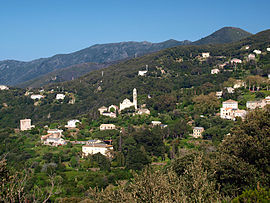Pino, Haute-Corse
You can help expand this article with text translated from the corresponding article in French. (December 2008) Click [show] for important translation instructions.
|
Pino | |
|---|---|
 The church and surrounding buildings in Pino | |
| Coordinates: 42°54′32″N 9°21′06″E / 42.9089°N 9.3517°E | |
| Country | France |
| Region | Corsica |
| Department | Haute-Corse |
| Arrondissement | Bastia |
| Canton | Cap Corse |
| Intercommunality | Cap Corse |
| Government | |
| • Mayor (2020–2026) | Francis Mazotti[1] |
Area 1 | 7.04 km2 (2.72 sq mi) |
| Population (2022)[2] | 154 |
| • Density | 22/km2 (57/sq mi) |
| Time zone | UTC+01:00 (CET) |
| • Summer (DST) | UTC+02:00 (CEST) |
| INSEE/Postal code | 2B233 /20228 |
| Elevation | 0–836 m (0–2,743 ft) (avg. 250 m or 820 ft) |
| 1 French Land Register data, which excludes lakes, ponds, glaciers > 1 km2 (0.386 sq mi or 247 acres) and river estuaries. | |
Pino (French pronunciation: [pino]; Corsican: Pinu) is a commune in the Haute-Corse department of France on the island of Corsica.
Geography
[edit]The town of Pino is located in the Eastern "Alpine Corsica", a distinction limited to the northeast of the island, composed of various terrains, originating from a former oceanic crust called Liguro-Piedmontese (a Tethys Ocean whose age is between -170 to -60 Ma) and its continental margins. In this part of Corsica, it is distinguished that the metamorphic schists or "lustrous schists" and the ophiolites of Cap Corse are of Jurassic and Cretaceous age.[3]
The commune occupies an "alveolus" in the western Cap Corse, a valley surrounded by mountains to the north, east, and south, which are also its territorial limits. Starting from the coast south of the Anse d'Aliso, its boundaries follow a ridge line from Punta d'Alisgia (155 m), Punta Pastricciola (305 m), to Monte Popolu (520 m). It then follows the Cape ridge southwards over the Bocca di Santa Lucia pass (387 m), beneath which lies the Santa Lucia chapel, past the Tour de Sénèque (566 m), Monte Rotto (630 m - Luri), Punta Rasiccia (714 m), and Monte Ventigliole (712 m) towards Monte Grofilieta (836 m). From there, it heads back west towards the sea, passing Monte Cupieta (756 m), Punta di Caterraggio (514 m), Punta di Piestrone (430 m), and follows the course of the small river, fiume di Mare Morto, to the coast.
Hydrography
[edit]On Pino's seafront are the mouths of six small rivers, all of which rise from the heights of the Pino Valley. From North to South, they are: the di Marinascu,[4] the di Fichetu,[5] the di Sorbinca,[6] the di A Pietra,[7] the di Cucchiara, and the di Mare Morto.
Climate and vegetation
[edit]Pino's geographical location on the Cape's western coastline means it is subject to the prevailing westerly winds. The soil is covered with tall holm oak trres and dense scrubland that conceal the ancient cultivation terraces, developing on a soil composed partly of silky, wrinkled sericite schists, and partly of very resistant ophiolites composed of volcanic rocks, causing sharp, abrupt reliefs in the ground. Many roads are cut into the rock, and feature prasinites on the walls, tinted green by epidote minerals.
The Santa Lucia Chapel is surrounded by laricio pines. On the rocky coastal slopes, are the numerous agave and prickly pear trees that originated in Mexico and have become widespread around the Mediterranean.
Population
[edit]
|
| |||||||||||||||||||||||||||||||||||||||||||||||||||||||||
| Source: EHESS[8] and INSEE (1968-2017)[9] | ||||||||||||||||||||||||||||||||||||||||||||||||||||||||||
Etymology
[edit]Pino derives from the Latin word pinus, meaning umbrella pine, a species of tree endemic to the commune.
See also
[edit]References
[edit]- ^ "Répertoire national des élus: les maires". data.gouv.fr, Plateforme ouverte des données publiques françaises (in French). 2 December 2020.
- ^ "Populations de référence 2022" (in French). The National Institute of Statistics and Economic Studies. 19 December 2024.
- ^ "La Course: Découverte géologique de l'Île de Beauté". Centre de Géologie de l'Oisans. 15 September 2010. Archived from the original (DOC) on 13 June 2023. Retrieved 13 June 2023.
- ^ Sandre. "Ruisseau de marinascu [Y7421040] - Cours d'eau selon la version Carthage 2017". www.sandre.eaufrance.fr (in French). Retrieved 12 June 2023.
- ^ Sandre. "Ruisseau de fichetu [Y7421080] - Cours d'eau selon la version Carthage 2017". www.sandre.eaufrance.fr (in French). Retrieved 12 June 2023.
- ^ "Rechercher une donnée d'un jeu". www.sandre.eaufrance.fr (in French). Retrieved 12 June 2023.
- ^ Sandre. "Ruisseau de belli forci [Y7421120] - Cours d'eau selon la version Carthage 2017". www.sandre.eaufrance.fr (in French). Retrieved 12 June 2023.
- ^ Des villages de Cassini aux communes d'aujourd'hui: Commune data sheet Pino, EHESS (in French).
- ^ Population en historique depuis 1968, INSEE



